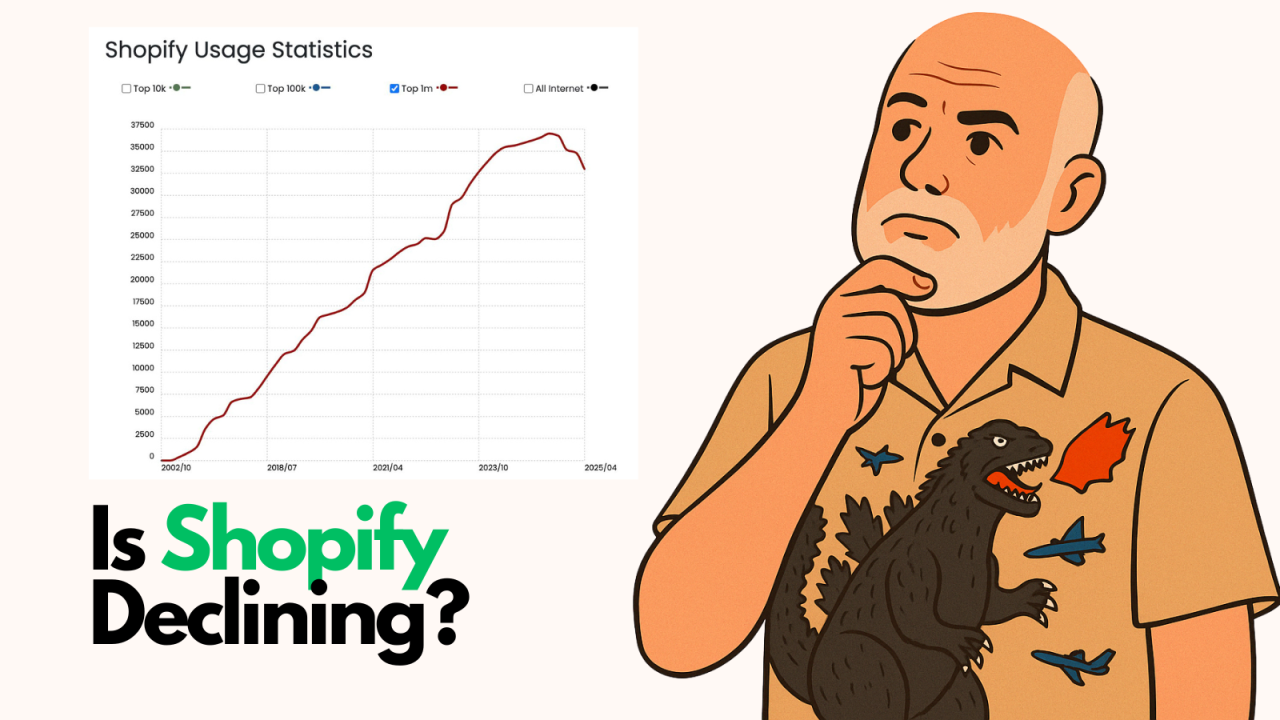

Nicklas Gellner from Medusa is talking about AI killing Shopify and he referenced this image from Builtwith (His post is here)

Please don’t get me wrong, I am not a Shopify Advocate, but Nicklas’s post got me interested, and I do research for a living now, so I dug in.
Let’s first talk about results.
Shopify's 2024 financial performance looks bulletproof—$8.88 billion in revenue (+26% YoY), $292.3 billion in GMV, and 2.6 million active stores. But I've learned that the most telling stories hide in the patterns beneath the headlines.

Let me share what I'm seeing in the real usage patterns:
The Traffic Paradox (2022-2025)
While some question the reliability of traffic data, the pattern aligns with what I'm seeing in direct merchant conversations and Shopify's own financial disclosures.Here's what the numbers don't tell you about Shopify's growth:
The Dependency Metrics

Strong financial metrics mask underlying user behavior shifts. The disconnect between Shopify's revenue growth and declining discovery traffic reminds me of the early enterprise software cycle, success built on switching costs rather than satisfaction.
Strategic complexity, simple solutions. That's what merchants want, but it's not what they're getting from increasingly complex platform ecosystems.
This is exactly why the AI development revolution matters so much...
The game changed when AI development tools made custom solutions accessible. Tools like Cursor, v0, and Loveable aren't just making development faster—they're democratizing what was once impossible for most merchants.
The New Reality
How AI transformed e-commerce development from months to hours

Shopify's success was built on removing constraints, making e-commerce accessible to everyone. But solving one set of constraints created new ones:
Technical Constraints
Financial Constraints
Strategic Constraints
Beyond the data, the conversations I'm having with merchants paint a picture that doesn't match the growth headlines:
Performance through human potential means giving people the tools to solve their own problems, not locking them into someone else's solution.
The disconnect between Shopify's traffic patterns and financial performance raises fundamental questions:
Are you growing because of your platform or despite it?
If 75% of your platform access is direct traffic, you're not growing through discovery—you're maintaining through habit. The question becomes: what happens when better alternatives become accessible?
AI development tools are changing the calculation. When custom development becomes accessible, the trade-offs that made platforms attractive start looking like unnecessary constraints.
The New Merchant Mindset
I'm watching for the merchants who will use AI to build what they actually need, not what someone else thinks they should want.
The data suggests we're at an inflection point. Shopify's financial strength gives them the runway to adapt, but the underlying usage patterns suggest merchants are ready for alternatives.
The Critical Questions
The story these numbers tell is that we're witnessing the early stages of a fundamental shift in how merchants think about e-commerce technology.
The next wave of e-commerce success will come from businesses that understand: technology serves humans, not the other way around.
The question isn't whether Shopify will adapt—it's whether you'll wait for them to, or start building your own path forward.
Ready to explore what's possible beyond platform constraints?
Let's talk about how AI-powered development might fit your business strategy. Sometimes the best way forward is the path you build yourself.
What patterns are you seeing in your business?
Are you growing because of your platform or despite it?
This analysis comes from watching e-commerce evolution and helping businesses navigate technology transitions. The data matters, but the human decisions behind the data matter more.
Key Data Points Referenced
"$8.88 billion in revenue for 2024 (+26% YoY)"
"2.6 million active stores"
"Peak website traffic: 148 million visits in November 2024"
"2025 decline: Notable dip in monthly active users from January to February 2025"
"Current ranking: #74 in the US, #146 globally"
"Revenue growth: $8.88B in 2024 (+26% YoY)"
"875M customers (+25% growth)"
"Store count: 2.6M+ stores"
"75.3% of Shopify's traffic now comes from direct visits, with only 12% from organic search"
"GMV fees, plugin overhead, and $2.5k/month Shopify Plus subscription"
"Shopify Plus subscription"
"3rd largest e-commerce platform"
"10.32% global market share"
"Monthly Recurring Revenue (MRR) growth"
"GMV Growth: $292.3B processed (+24%)"
"Q3 2024: $2.16 billion revenue"
"Q4 2024: $2.81 billion revenue"
All traffic data comes from third-party analytics services (SimilarWeb, Semrush) as Shopify does not publicly disclose detailed website traffic statistics. Financial data comes from official Shopify investor relations reports and SEC filings.
Primary Data Sources:
Data Collection Period: January 2023 - July 2025 Last Updated: July 2025

Following up on my earlier post about BigCommerce's rebrand announcement, I got my hands on theCleveland...

The B2B OG Reality Check In 1995, I built my first B2B website for my then computer assembly company. It...

"No CTO ever got fired for choosingShopify"